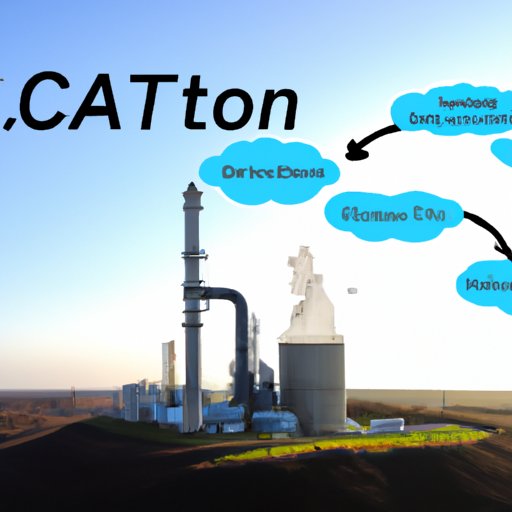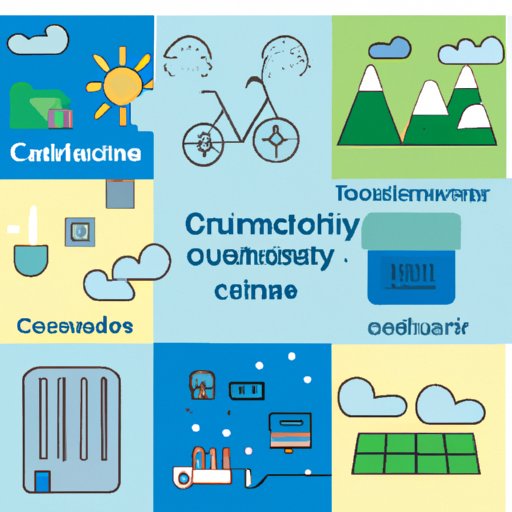Introduction
Climate change is one of the biggest challenges facing our planet today. In order to successfully mitigate the effects of climate change, it is essential to identify and implement innovative technological solutions that can help reduce emissions and improve sustainability. This article will explore how different types of technology can be utilized to address climate change in a variety of ways.
Exploring Renewable Energy Sources
One of the most effective ways to reduce emissions is to utilize renewable energy sources instead of traditional fossil fuels. Renewable energy sources are clean and abundant, and they offer many advantages over traditional energy sources. Some of the benefits of renewable energy sources include reducing air pollution, creating jobs, increasing energy security, and providing more stable electricity prices.
There are several different types of renewable energy sources available, including solar, wind, hydropower, geothermal, and biomass energy. Each of these sources has its own unique advantages and disadvantages, and it is important to consider all of these factors when choosing the best type of renewable energy for a particular application. Additionally, there are some challenges associated with implementing renewable energy sources, such as high initial costs and limited access to infrastructure.

Utilizing Smart Technology to Monitor Environmental Impact
Smart technology can be used to monitor environmental conditions in order to identify potential areas of concern. Smart sensors and other monitoring devices can be used to measure air quality, water quality, and other factors which may indicate the presence of pollutants or other harmful substances. These devices can then be used to alert authorities if any hazardous levels are detected, allowing for quick action to be taken.
The benefits of using smart technology for monitoring include increased accuracy and efficiency in identifying environmental issues, as well as the ability to track changes over time. Additionally, such technology can be used to provide real-time information on current conditions and trends, allowing for better informed decisions to be made. Examples of smart technology used for monitoring include airborne drones, satellite imagery, and ground-based sensors.
However, there are also some challenges associated with adopting such technology. For example, there may be high costs associated with purchasing and implementing such technology, and there may be privacy concerns if data collected from such devices is shared with third parties.
Developing Low-Carbon Technologies
Low-carbon technologies are those which use less carbon dioxide (CO2) than traditional methods. Such technologies can be used to reduce emissions by replacing existing processes which generate high levels of CO2 with more efficient alternatives. Examples of low-carbon technologies include electric vehicles, renewable energy sources, energy-efficient buildings, and energy storage systems.
The benefits of low-carbon technologies include reduced emissions, improved energy efficiency, and cost savings. Additionally, such technologies can help to reduce dependence on fossil fuels, thereby decreasing the amount of CO2 released into the atmosphere. There are also some challenges associated with developing and implementing such technologies, such as high initial costs and the need for new regulations and policies.

Implementing Carbon Capture and Storage Solutions
Carbon capture and storage (CCS) is a technology which involves capturing CO2 emissions from industrial processes and storing them underground or in the ocean. The benefits of CCS include reducing emissions, improving energy efficiency, and providing a long-term solution for managing CO2. Examples of CCS solutions include direct air capture, bioenergy with carbon capture and storage (BECCS), and enhanced oil recovery (EOR).
However, there are also some challenges associated with implementing CCS solutions. For example, there may be high costs associated with constructing and maintaining infrastructure, and there may also be risks associated with storing large amounts of CO2 underground or in the ocean. Additionally, there may be political and regulatory obstacles which could prevent the implementation of CCS solutions.
Enhancing Agricultural Practices with Technology
Agriculture accounts for a significant portion of global emissions, and it is essential to find ways to reduce emissions from this sector. Technology can play an important role in helping to reduce emissions from agriculture, as well as improve efficiency and productivity. Examples of technology used in agriculture include precision agriculture, digital agriculture, and remote sensing.
The benefits of using technology in agriculture include improved crop yields, reduced water usage, and decreased use of pesticides and fertilizers. Additionally, such technology can be used to track and monitor environmental conditions, allowing for better informed decision making. However, there are also some challenges associated with using technology in agriculture, such as high initial costs and limited access to infrastructure.

Increasing Efficiency in Transportation Systems
Transportation systems account for a significant portion of global emissions, and it is essential to find ways to reduce emissions from this sector. Technology can play an important role in helping to reduce emissions from transportation, as well as improve efficiency and safety. Examples of technology used to increase efficiency in transportation systems include electric vehicles, autonomous vehicles, connected vehicles, and intelligent transportation systems.
The benefits of increasing efficiency in transportation systems include reduced emissions, improved safety, and cost savings. Additionally, such technology can be used to provide real-time information on traffic conditions and trends, allowing for better informed decisions to be made. However, there are also some challenges associated with increasing efficiency in transportation systems, such as high initial costs and the need for new regulations and policies.
Utilizing Big Data to Track Climate Change Effects
Big data can be used to track the effects of climate change on the environment. By collecting data from various sources and analyzing it, scientists can gain valuable insights into the current state of the environment and how it is changing over time. This information can then be used to inform decision making and develop strategies for mitigating the effects of climate change.
The benefits of using big data for tracking climate change effects include increased accuracy and efficiency in identifying trends and patterns, as well as the ability to track changes over time. Examples of big data used for tracking climate change effects include satellite imagery, climate models, and sensor networks. However, there are also some challenges associated with using big data for tracking climate change effects, such as high costs and limited access to infrastructure.
Conclusion
Technology provides numerous solutions to help address climate change. This article has explored different types of technology that can be used to reduce emissions, such as renewable energy sources, smart technology, low-carbon technologies, carbon capture and storage, agricultural practices, transportation systems, and big data. It is essential that governments, businesses, and individuals work together to identify and implement innovative technological solutions which can help reduce emissions and improve sustainability.
In order to successfully mitigate the effects of climate change, it is essential to take action now. Governments, businesses, and individuals must come together to identify and implement innovative technological solutions which can help reduce emissions and improve sustainability. Additionally, it is important to continue to research and develop new technologies which can help address climate change in the future.
(Note: Is this article not meeting your expectations? Do you have knowledge or insights to share? Unlock new opportunities and expand your reach by joining our authors team. Click Registration to join us and share your expertise with our readers.)
